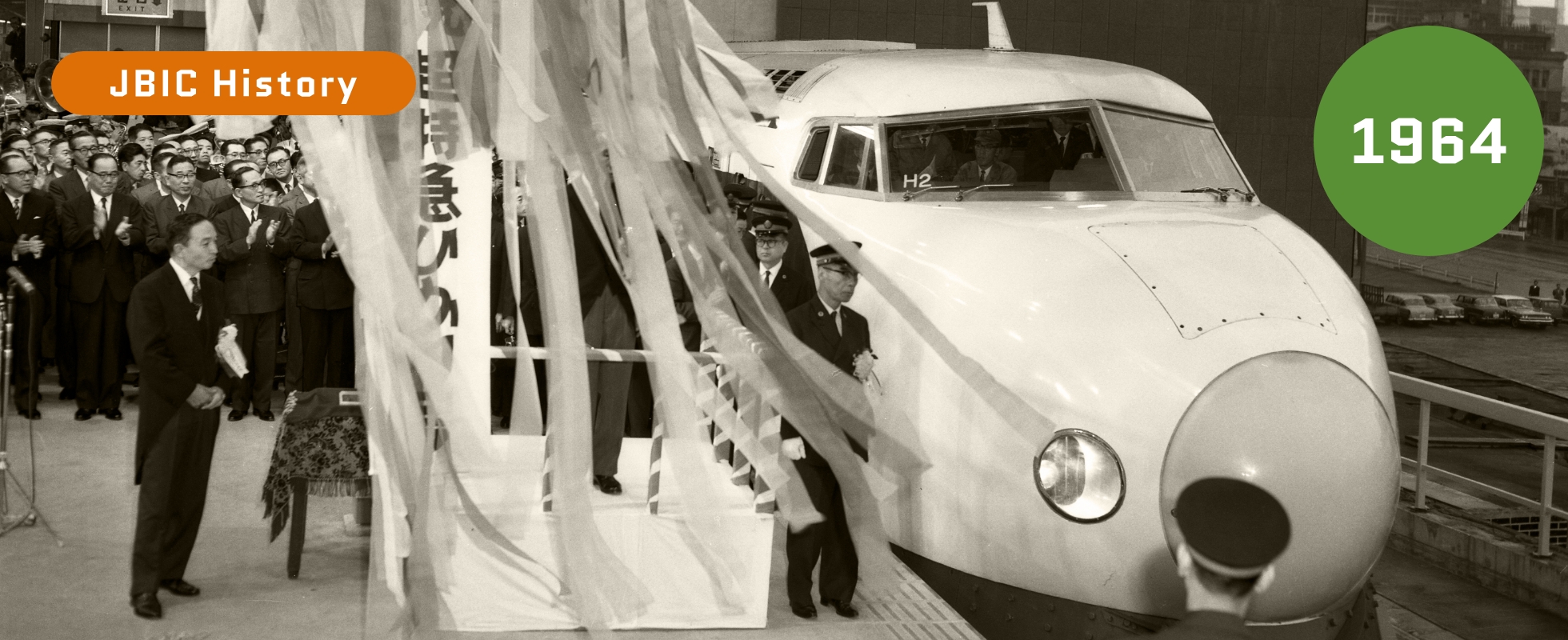JBIC History Vol.2
A look back at the steps taken by JBIC's predecessor, the Export-Import Bank of Japan (JEXIM), and the postwar history of the Japanese economy. Japan overcame three obstacles to join the OECD in 1964.


Financed by the World Bank, the Tokaido Shinkansen (bullet train) opened for service to coincide with the Tokyo Olympic Games (October 1964). In April of the same year, Japan joined the OECD. ©The Asahi Shimbun / amanaimages
Three obstacles: Bretton Woods, GATT, and post-war reparations
Immediately after the end of World War II, it became imperative for Japan to establish itself as a trading nation because it had few natural resources. But as Japan sought ways to participate in the world economic system, it came up against three obstacles.
First was participation in the Bretton Woods system, the U.S.-initiated global financial system centered on the World Bank and the IMF. Second was membership of the General Agreement on Tariffs and Trade (GATT), the predecessor to the WTO. And third was resolving the issue of reparations. Japan overcame these obstacles and achieved rapid economic growth, and was then able to join the OECD in 1964.
The Japanese government’s first approach to the World Bank and the IMF was in April 1950, when Finance Minister IKEDA met with U.S. economic advisor Dodge to discuss the establishment of JEXIM. For Japan’s economy, which was struggling with a current account deficit, there were substantial advantages to receiving foreign currency loans under the Bretton Woods system. The GHQ was indifferent to this at first, but the situation took a turn for the better when General MacArthur was relieved of his command. With the support of the U.S., Japan became a member of the World Bank and the IMF in August 1952.
Japan was able to borrow the foreign currency needed for postwar reconstruction from the World Bank. The loans were used to build much of the country’s economic infrastructure that underpinned Japan’s rapid economic growth, including the Tokaido Shinkansen, the Tomei and Meishin Expressways, and the Kurobe Dam.
Next was the coveted membership of GATT. Japan formally applied to join in July 1952, but was met with unexpected opposition from the countries of Europe, reflecting a deep-seated wariness over the prewar dumping of Japanese textile products. But with U.S. support, Japan was finally able to join GATT in September 1955. Japan was forced to self-regulate textile exports even after its accession, but GATT membership had symbolic meaning for the nation’s return to the international community. Japan’s exports subsequently expanded from textiles to the chemical and heavy industries, and became the main engine driving its rapid economic growth.
Payment of reparations and JEXIM. First non-Western country to join the OECD
This was also the period when the signing of the Peace Treaty accelerated negotiations over reparations to war-damaged countries. Japan first sought to resolve the issue of reparations with the countries of Southeast Asia in order to normalize trade relations.
Payment of reparations began in 1955, and JEXIM was central in the financing of economic cooperation projects that accompanied the reparations. Japan’s economic cooperation began with reparation payments. As Japan’s industries became increasingly sophisticated, its exports of plant, along with chemical and heavy industry products, such as steel, ships, and machinery, grew in tandem. JEXIM’s activities including export loans and overseas investment loans also increased as a result, supporting Japan’s rapid economic growth from the financial side.
And so, in April 1964, Japan became the first non-Western country to join the OECD. Japan was now expected to take on more responsibility as a developed country.
■Participation in the World Economic System
| 1952 | August | Joined World Bank and IMF |
|---|---|---|
| 1955 | September | Joined GATT |
| 1956 | December | Joined United Nations (UN) |
| 1960 | December | Prime Minister IKEDA Hayato announces the Income Doubling Plan |
| 1964 | April | Joined OECD |
| October | Tokaido Shinkansen Line opens for service Tokyo Olympic Games |






